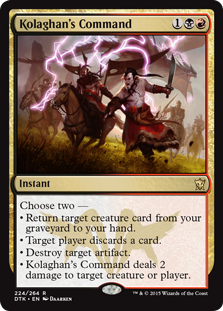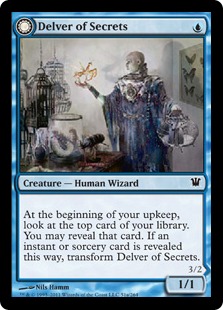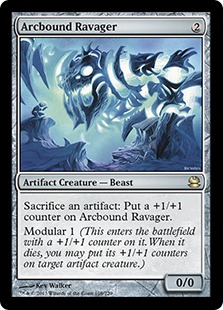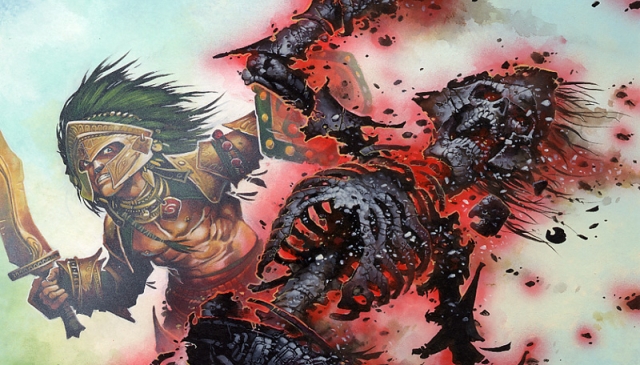Are you a Quiet Speculation member?
If not, now is a perfect time to join up! Our powerful tools, breaking-news analysis, and exclusive Discord channel will make sure you stay up to date and ahead of the curve.
We've seen some interest in Saturday articles for a while now, and with the MTGO Modern Festival Finals coming up on Sunday, July 5, there hasn't been a better time to fire off a pre-event article to prepare players for Sunday's showdown. The tournament winner goes home with one copy of every single Modern-legal set, so the stakes are high for the Modern MTGO community. And if you go into an event this big without understanding the metagame, don't be surprised to end up like this guy below.
In the week leading up to the Festival Finals, we saw five-round Festival Preliminaries replace the usual MTGO Modern Daily schedule. This gives players a wealth of information about the pre-Finals metagame. There are lots of ways to slice and dice metagame information, and these Modern Festival Preliminaries are no exception. This article is going to break things down in two ways. First, we're going to take a high-level look at the decks that showed up at the Preliminaries. This doesn't necessarily give us the best sense of how the Finals will look, but it does help us understand how the wider Modern community is playing the format. Then we are going to look at the Preliminary players who qualified for the finals, seeing if this sub-metagame is a better predictor of the upcoming Finals.
[wp_ad_camp_1]
Describing the Preliminary Metagame
We can't do a metagame breakdown without some simple, descriptive statistics of different deck prevalences, but I actually don't think this is the best way to analyze the Preliminaries. At least, not the only way we should do it. The Preliminaries have a unique structure and format we need our analysis to reflect. The big issue here is that these events have lots of repeat players. Fully 31% of Preliminary players were in 2+ events. Just under 10% were in 3+. This puts our metagame a little too much at the mercy of player deck preference, so we need to account for this in our breakdown. A second issue is one of population size. We have just over twenty events in our dataset, only reporting on players with 9+ points. All the players with less than 6 points (hundreds and hundreds of them) aren't included here. That's less of an issue when we analyze MTGO data on a monthly basis because our N is so much bigger. It might be a bigger problem here.
The table below gives the metagame shares for all decks with above-average prevalence. These decks makes up about 78% of all decks in the Preliminaries, which is also roughly what we see in the tier 1 and tier 2 of metagame breakdowns. In addition to their basic prevalence, I'm going to give two other stats. One is their share only among unique player/deck pairings. This will help us account for the effects of player preference. I'm also going to give the margin of error for each deck's metagame-wide share. This gives us some sense for the variance in each deck's observed share.
| Deck | Preliminary Meta% | Margin of Error | Meta% Unique Player/Decks |
|---|---|---|---|
| Burn | 10.5% | 2% | 9.8% |
| Affinity | 8.9% | 1.8% | 7.5% |
| Grixis Control | 8.1% | 1.8% | 7.9% |
| Jund | 7% | 1.6% | 7.4% |
| Grixis Delver | 4.8% | 1.4% | 4.6% |
| RG Tron | 4.6% | 1.4% | 4.1% |
| Grixis Twin | 4.5% | 1.3% | 5% |
| UR Twin | 4% | 1.3% | 4.4% |
| Merfolk | 3.5% | 1.2% | 3.6% |
| Amulet Bloom | 3.4% | 1.2% | 3.8% |
| Elves | 2.9% | 1.1% | 3.4% |
| Naya Zoo | 2.8% | 1.1% | 3% |
| Living End | 2.5% | 1% | 2.5% |
| Grishoalbrand | 2.1% | .9% | 2.2% |
| Temur Twin | 1.9% | .9% | 2% |
| Abzan | 1.7% | .8% | 1.7% |
| Infect | 1.7% | .8% | 2.1% |
| Scapeshift | 1.4% | .8% | 1.5% |
| Abzan Company | 1.3% | .8% | 1.3% |
I initially did this table as a Top 10 list, but there were just too many cool decks underneath the Top 10 to leave them out. So the table's a little longer than I would like, but I think it's important to have all that information in one place for sorting.
The biggest takeaway for me is that the overall metagame % is basically identical to the unique player/deck adjusted metagame %. Sorting on that first column, we see Burn, Affinity, Grixis Control, Jund, Grixis Delver, and RG Tron. Sorting on that last column, the decks are identical except for UR Twin replacing RG Tron, and small variations in the order. This is also true even further down the list. All of this suggests a fairly stable metagame. Players may have participated in numerous Preliminary events this past week (remember: 31% of them did 2+), but they didn't have some bizarre deck preferences that were different from the overall metagame.
 The second biggest takeaway is the success of Grixis. We see the usual suspects like Burn, Jund, and Affinity, but Grixis Control is a huge addition to the list. We even see Grixis Delver and Grixis Twin up there in the Top 10, which is one reason I give credit to the color pairing and not just Grixis Control as a standalone deck. No one should be too surprised at all the Grixis running around, especially if you've been following articles here on Delver, Twin, and Control. We've also seen a lot of Grixis in the metagame updates, including both the May update and the GP Copenhagen retrospective. This is important for a few reasons. First, it means you can expect a lot of Grixis both in the Finals and in the overall metagame. Prepare for lots of Kolaghan's Command, Tasigur, the Golden Fang, and Terminate. Second, it means Modern has an important fair, nonlinear, highly-interactive deck we can count on. Grixis Twin isn't quite in this category, but Grixis Control definitely is and that deck is currently leading the Grixis pack. It's healthy for the format to have these decks at the top, even if they are accompanied by the usual linear suspects of Burn and Affinity. Finally, the margin of error and deck prevalences suggest that we won't always know which Grixis deck is seeing the most play. The lower end of Grixis Control is about 6.3% (8.1% minus the margin of error of 1.8%), which is actually about equal to the higher end of Grixis Delver with 6.2%. So expect to see lots of Grixis generally, but don't bank too heavily on one particular Grixis decktype.
The second biggest takeaway is the success of Grixis. We see the usual suspects like Burn, Jund, and Affinity, but Grixis Control is a huge addition to the list. We even see Grixis Delver and Grixis Twin up there in the Top 10, which is one reason I give credit to the color pairing and not just Grixis Control as a standalone deck. No one should be too surprised at all the Grixis running around, especially if you've been following articles here on Delver, Twin, and Control. We've also seen a lot of Grixis in the metagame updates, including both the May update and the GP Copenhagen retrospective. This is important for a few reasons. First, it means you can expect a lot of Grixis both in the Finals and in the overall metagame. Prepare for lots of Kolaghan's Command, Tasigur, the Golden Fang, and Terminate. Second, it means Modern has an important fair, nonlinear, highly-interactive deck we can count on. Grixis Twin isn't quite in this category, but Grixis Control definitely is and that deck is currently leading the Grixis pack. It's healthy for the format to have these decks at the top, even if they are accompanied by the usual linear suspects of Burn and Affinity. Finally, the margin of error and deck prevalences suggest that we won't always know which Grixis deck is seeing the most play. The lower end of Grixis Control is about 6.3% (8.1% minus the margin of error of 1.8%), which is actually about equal to the higher end of Grixis Delver with 6.2%. So expect to see lots of Grixis generally, but don't bank too heavily on one particular Grixis decktype.
The last aspect of the Preliminary metagame I want to discuss is the bottom of the table. It would be one thing if we had some oddball tier 2/tier 3 decks down there like Bogles, Living End, Ad Nauseam, etc. Instead, we have Abzan, Grishoalbrand, and Abzan Company, big format names that we probably expected to do better. Before we turn to the Finals predictions, here are some notes on each of these decks.
 Abzan: Siege Rhino, we hardly knew ye. I don't think we've seen the end of Abzan, and I don't even think the metagame-wide Abzan share is quite as low as it is in the Festival Preliminaries. But there's something about the current metagame that is highly hostile to Abzan, and it's reflected here as much as it was at the previous three GPs. To some extent, we would think Abzan's resilience to Lightning Bolt would make it pretty good in this Jund and Grixis-packed metagame. But losing access to Bolt, Kolaghan's Command, Terminate, and other RBx cards is apparently much worse than being Bolt-resilient yourself. Abzan may come back, but it's unlikely to come back this weekend.
Abzan: Siege Rhino, we hardly knew ye. I don't think we've seen the end of Abzan, and I don't even think the metagame-wide Abzan share is quite as low as it is in the Festival Preliminaries. But there's something about the current metagame that is highly hostile to Abzan, and it's reflected here as much as it was at the previous three GPs. To some extent, we would think Abzan's resilience to Lightning Bolt would make it pretty good in this Jund and Grixis-packed metagame. But losing access to Bolt, Kolaghan's Command, Terminate, and other RBx cards is apparently much worse than being Bolt-resilient yourself. Abzan may come back, but it's unlikely to come back this weekend.
 Grishoalbrand: I've played a lot of Griselbrand and Grishoalbrand in Modern, and I can safely say this is a very strong deck. But it's not quite as strong as the hype-train and ban-maniacs would have us believe, and nothing quite proves that like the Preliminaries. If this deck was truly some unbeatable, turn 2-3 monster, we would expect to see a lot more of it. But the deck just isn't putting up numbers right now, which is happening both on MTGO and across the wider Modern metagame (the deck has yet to get above 3% even for the Grand Prix metagames). Given how strong the deck is in a vacuum, my guess is that its mediocre performances are related to sideboard cards and other maindeck answers (Scavenging Ooze and Dispel are huge here).
Grishoalbrand: I've played a lot of Griselbrand and Grishoalbrand in Modern, and I can safely say this is a very strong deck. But it's not quite as strong as the hype-train and ban-maniacs would have us believe, and nothing quite proves that like the Preliminaries. If this deck was truly some unbeatable, turn 2-3 monster, we would expect to see a lot more of it. But the deck just isn't putting up numbers right now, which is happening both on MTGO and across the wider Modern metagame (the deck has yet to get above 3% even for the Grand Prix metagames). Given how strong the deck is in a vacuum, my guess is that its mediocre performances are related to sideboard cards and other maindeck answers (Scavenging Ooze and Dispel are huge here).
 Abzan Company: Not a great week for those BGW mages... Collected Company remains a strong card, and we are seeing it across the metagame in big decks like Elves and Naya Company, as well as less common ones like Bant Company and some splashed Merfolk lists. Unfortunately for Melira and Finks players everywhere, Abzan Company as a specific deck does not seem to be the optimal Company list for now. From what I've seen of the metagame, it just seems a little too fair for the current metagame, without any of the interactive pieces that help fair decks like Jund and Grixis Control cut it in today's format. It's tempting to say that Company as a card isn't viable, but we've seen enough performance from this card in the past month to know that's not true. This card was all over the GPs and the broader metagame, so we know the card is fine itself. But Abzan Company might not be the best home for the card right now.
Abzan Company: Not a great week for those BGW mages... Collected Company remains a strong card, and we are seeing it across the metagame in big decks like Elves and Naya Company, as well as less common ones like Bant Company and some splashed Merfolk lists. Unfortunately for Melira and Finks players everywhere, Abzan Company as a specific deck does not seem to be the optimal Company list for now. From what I've seen of the metagame, it just seems a little too fair for the current metagame, without any of the interactive pieces that help fair decks like Jund and Grixis Control cut it in today's format. It's tempting to say that Company as a card isn't viable, but we've seen enough performance from this card in the past month to know that's not true. This card was all over the GPs and the broader metagame, so we know the card is fine itself. But Abzan Company might not be the best home for the card right now.
Predicting the Final Metagame
These Preliminary-wide metagame shares are important for Modern as a whole because they give us a sense of the overall metagame. But I also think they aren't the best predictors for the Finals metagame on Sunday. If nothing else, we know that those numbers include players with only 9 points when the cutoff for Finals qualification was 12 or more. The Sunday metagame will also include people metagaming against the known metagame, so they will be one step ahead of the descriptive stats above. But the good news here is that we actually have all those 12+ points lists, which means we know a huge chunk of the players who will show up on Sunday. Because we have those players' names and decks, we can also make educated guesses about what decks those players might bring to Sunday, especially if they played those decks repeatedly throughout the week.
Given those factors, the table below attempts to predict what Sunday will look like. This includes the metagame shares for decks that earned 12+ points, which is just the share of all decks that qualified for Sunday. The table also includes a third column, which represents an adjustment to the 12+ point percentage column based on what decks had repeat pilots. Decks with more repeat pilots get greater weight in their numbers. I'll also give the Preliminary metagame percentage, just as a reference point.
This time, let's just stick with a Top 10 list.
| Deck | Predicted Finals Meta% | Preliminary Meta% | Adjusted Finals Meta% |
|---|---|---|---|
| Burn | 9.3% | 10.5% | 10.2% |
| Affinity | 8.1% | 8.9% | 10.9% |
| Grixis Control | 9.3% | 8.1% | 9.7% |
| Jund | 7.3% | 7% | 6.7% |
| Grixis Delver | 3.8% | 4.8% | 3.8% |
| RG Tron | 5.3% | 4.6% | 5.8% |
| Grixis Twin | 4.5% | 4.5% | 3.4% |
| UR Twin | 4.9% | 4% | 4.3% |
| Merfolk | 3.8% | 3.5% | 3.4% |
| Amulet Bloom | 3.4% | 3.4% | 2.7% |
 The predicted Finals metagame is fairly similar to the Preliminary metagame in the section above, but with a few key differences that will matter on Sunday. First, Grixis Delver drops off considerably between the purely descriptive Preliminary metagame percentages and the predictive numbers in this table. In the Preliminaries, this was the 5th most-played deck, and it might have been even higher given its margin of error. But here, Grixis Delver has fallen down to 8th, with RG Tron taking its place and the UR/Grixis Twin decks rising instead. This suggests that Delver of Secrets is not the best backbone for a Grixis deck (the Grixis Control decks without Delver did great in the 12+ points metagame). At least, Delver might not be popular at the Modern Festival Finals this Sunday. It looks like Grixis mages are going to stick with their trusty Grixis Control lists, and it's possible that Grixis Delver players will ditch the tempo all-star just to reflect what everyone else is probably doing. Be ready for this on Sunday.
The predicted Finals metagame is fairly similar to the Preliminary metagame in the section above, but with a few key differences that will matter on Sunday. First, Grixis Delver drops off considerably between the purely descriptive Preliminary metagame percentages and the predictive numbers in this table. In the Preliminaries, this was the 5th most-played deck, and it might have been even higher given its margin of error. But here, Grixis Delver has fallen down to 8th, with RG Tron taking its place and the UR/Grixis Twin decks rising instead. This suggests that Delver of Secrets is not the best backbone for a Grixis deck (the Grixis Control decks without Delver did great in the 12+ points metagame). At least, Delver might not be popular at the Modern Festival Finals this Sunday. It looks like Grixis mages are going to stick with their trusty Grixis Control lists, and it's possible that Grixis Delver players will ditch the tempo all-star just to reflect what everyone else is probably doing. Be ready for this on Sunday.
 Another important conclusion is the relative success of Affinity and Burn, the tier 1 linear decks that continue to define Modern. Both of these decks go through upticks and downticks in popularity and success, an this weekend looks like it will be an uptick for both. Affinity was an incredibly successful deck throughout the week: although it was only in third for its 12+ points metagame share (8.1%), it had tons of successful, repeat players. When we sort on the adjusted metagame percent column, Affinity shoots up to 10.9%, making it our frontrunner for Sunday's most popular deck. Burn has similar success, with its baseline share of 9.3% in the 12+ points category increasing to 10.2% in the adjusted column. Players committed to these decks all week and were rewarded for it, and Sunday might tell a similar story. Of course, Burn and Affinity are also some of the easier decks to metagame against. Pack in your sideboard (and maindeck!) hatred if you want to have a successful Finals event: Kolaghan's Command, Dispel, Kitchen Finks, Feed the Clan and others all come to mind. If players are smart and read into these metagame stats, they can get ahead of the Burn and Affinity players and crush them on Sunday. If not, expect to see lots of Eidolons and Ravagers all day.
Another important conclusion is the relative success of Affinity and Burn, the tier 1 linear decks that continue to define Modern. Both of these decks go through upticks and downticks in popularity and success, an this weekend looks like it will be an uptick for both. Affinity was an incredibly successful deck throughout the week: although it was only in third for its 12+ points metagame share (8.1%), it had tons of successful, repeat players. When we sort on the adjusted metagame percent column, Affinity shoots up to 10.9%, making it our frontrunner for Sunday's most popular deck. Burn has similar success, with its baseline share of 9.3% in the 12+ points category increasing to 10.2% in the adjusted column. Players committed to these decks all week and were rewarded for it, and Sunday might tell a similar story. Of course, Burn and Affinity are also some of the easier decks to metagame against. Pack in your sideboard (and maindeck!) hatred if you want to have a successful Finals event: Kolaghan's Command, Dispel, Kitchen Finks, Feed the Clan and others all come to mind. If players are smart and read into these metagame stats, they can get ahead of the Burn and Affinity players and crush them on Sunday. If not, expect to see lots of Eidolons and Ravagers all day.
Preparing for the Modern Festival Finals
I'm excited to see how the Sunday Finals compare to both the Preliminary metagames and the predicted Finals metagames described above. But remember when going into Sunday's event that quantitative metagame analysis is only one tool we can use to sharpen our understanding of the format. We need to combine that with both our personal experience and the overall context across all Modern events. For instance, Grishoalbrand may have been a major underperformer during the week, but we know this deck can catapult a few players to the top tables (as it did at every previous GP in June). That means you would be foolish either to dismiss the deck as a potential contender, and to ignore the deck in your sideboarding strategies.
What do you expect to see on Sunday? What's your preparation strategy if you are playing in the event? How do you like these Saturday articles? Let me know in the comments and, if you one of those silly U.S. of A. people like me, enjoy your Fourth of July weekend!






Which deck would you rather play tommorow – Amulet Bloom or Grishoalbrand?
I think Amulet Bloom is the better option right now. Both decks are equally strong, with a slight edge to Grishoalbrand, against opponents who can’t get that turn 1-3 interaction. But against opponents who are trying to interact and do have their hate cards, Amulet Bloom is going to be better. For Bloom, it’s really just Moon you have to worry about, and even then you can get around that with smart plays and deckbuilding (e.g. Coalition Relic in the board). For Grishoalbrand, you have to worry about both the graveyard hate and the countermagic, and from what I’m seeing in the Prelim lists there’s way more of that than there is Moon.
That said, I would personally pick Grishoalbrand because I’m better with the deck. But assuming you know both about equally well, Amulet seems better.
Great article, thanks for the writeup.
I’m interested to see whether or not Day’s Undoing further increases Affinity’s share of the metagame after origins.
My bet is that it will.